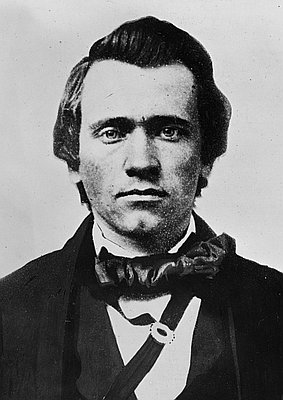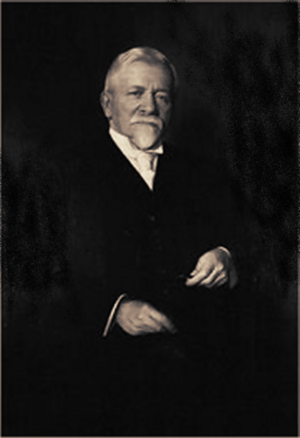Henry Pittock facts for kids
Quick facts for kids
Henry Pittock
|
|
|---|---|

Pittock c. 1861
|
|
| Born |
Henry Lewis Pittock
March 1, 1835 London, England
|
| Died | January 28, 1919 (aged 83) Portland, Oregon, U.S.
|
| Occupation |
|
| Spouse(s) |
Georgiana Burton Pittock
(m. 1860) |
Henry Lewis Pittock (born March 1, 1835 – died January 28, 1919) was an important American pioneer and a successful businessman. He was born in London, England. Henry Pittock became famous as a publisher and newspaper editor. He helped make The Oregonian newspaper very popular. He also loved the outdoors and adventures. Today, the beautiful Pittock Mansion in Portland, Oregon is a museum. It tells the story of Henry Pittock and his family.
Contents
Henry Pittock's Life Story
Growing Up and Moving West
Henry Lewis Pittock was born in London, England. When he was four, his family moved to Pittsburgh, Pennsylvania, in the United States. His father, Frederick Pittock, started a printing business there. Henry was the third of eight children.
From age twelve, Henry worked in his father's print shop. He also went to a preparatory school in Pittsburgh. At seventeen, he left home with his brother, Robert. They were inspired by exciting frontier stories. They joined other families to travel west.
Starting a New Life in Oregon
In October 1853, Pittock arrived in the Oregon Territory. He had no money and no shoes. He tried to get a job as a printer at the Oregon Spectator newspaper. This was the first big newspaper in Oregon City, Oregon. But they did not hire him.
He turned down a job as a bartender. Instead, he found work as a typesetter for the Oregonian newspaper in Portland. The editor, Thomas J. Dryer, gave him a place to sleep. Henry slept under the front counter. After six months, he started earning $900 a year.
Over the next six years, Pittock earned a share of the newspaper. Mr. Dryer was often busy with politics and couldn't pay him. So, Henry Pittock took over managing and editing the newspaper.
In 1860, Henry married Georgiana Martin Burton. Her father owned a flour mill. Henry and Georgiana had five children. They lived in a small house on land he bought for $300 in 1856. This land is now known as the "Pittock Block."
First to Climb Mount Hood?
Henry Pittock loved being outdoors and going on adventures. He is believed to be the first white person to climb Mount Hood. He reached the top on July 11, 1857, with four friends. His boss, Mr. Dryer, also said he climbed it earlier, but this is debated.
Becoming a Newspaper Boss
In 1861, Abraham Lincoln became president. He gave Mr. Dryer a political job. Mr. Dryer then gave the Oregonian to Pittock. The newspaper was in debt, but Pittock agreed to take on its financial problems. This was also payment for his unpaid salary.
On February 4, 1861, Pittock started publishing the Morning Oregonian every day. He bought a new steam-powered press for this bigger newspaper. There were three other daily newspapers in Portland. The competition was tough.
To get ahead, Pittock created a special system. He wanted news about the Civil War faster than anyone else. The closest telegraph line ended in Yreka, California. So, Pittock arranged for pony express riders and stagecoaches to carry news. This way, the Oregonian got news days before its rivals. Other papers waited for news to arrive by ship from San Francisco.
Pittock also fixed the newspaper's money problems. He made people pay cash for subscriptions. He also worked hard to collect money that Mr. Dryer had not collected. Soon, The Oregonian became stable and the most important newspaper in Portland. He invested in new equipment to stay ahead.
Building a Business Empire
In 1866, Pittock became a partner in the first paper mill in the Northwest. This mill was in Oregon City. Later, he helped build a second mill there and another in Camas, Washington. These mills made newsprint for The Oregonian. They also supplied paper for the Portland Evening Telegram, which Pittock started in 1877.
The paper mills grew into a very successful company. They later became part of the large Georgia Pacific company. Pittock's business interests grew to include banks, real estate, transportation, and logging.
In 1909, he began building a large, 22-room mansion. It was built on 46 acres of land. This beautiful home is now a public landmark called the Pittock Mansion. The "Pittock block" in downtown Portland became very valuable. In 1912, he leased it for a lot of money.
Pittock also founded the Northwestern National Bank Company in 1912. He was its president until he died.
Later Years and Legacy
Henry Pittock continued to manage his newspaper. He worked long hours in his office until just days before he died. He became sick with influenza. It is said he was carried to a window in his mansion. He wanted to look one last time at the city where he had built his fortune.
He died the next night, on January 28, 1919, in Portland. He left behind a very large estate. It was worth over $7.8 million, which was a huge amount of money back then. Pittock was buried at River View Cemetery in Portland.
In his will, he made sure that The Oregonian newspaper would be managed by trustees for 20 years. This showed he wanted to keep control even after his death. Eventually, the newspaper was sold to other companies.
In 1979, Henry Pittock was one of the first people added to the Oregon Newspaper Hall of Fame. His longtime editor, Harvey W. Scott, was also inducted at the same time.
|




